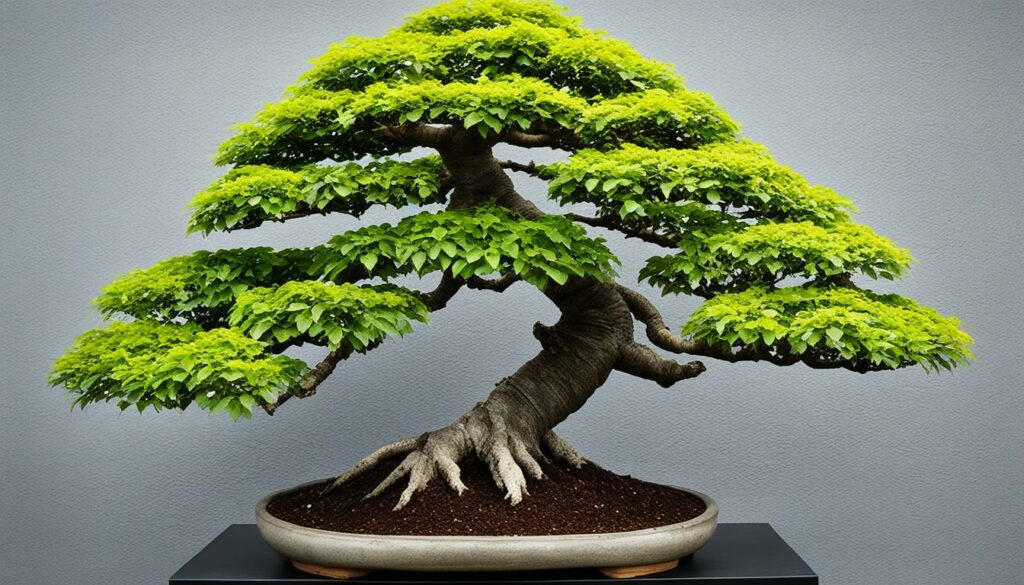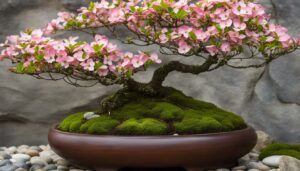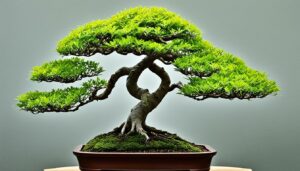Discover the world of bonsai trees and explore the enduring qualities of the Hornbeam Beech bonsai. Its robust nature and striking beauty make it a sought-after species among bonsai enthusiasts, and with good reason.
The Hornbeam Beech bonsai is a deciduous tree that can create a captivating display in your home. Its unique features and ability to withstand pruning and shaping make it an excellent choice for beginners and experienced bonsai cultivators alike.
Key Takeaways:
- The Hornbeam Beech bonsai is a sturdy and enduring species that can create a striking bonsai display in your home.
- It is a deciduous tree known for its unique features and ability to withstand pruning and shaping.
- The Hornbeam Beech bonsai is sought-after by bonsai enthusiasts, making it an excellent choice for beginners and experienced cultivators.
- Proper care and maintenance are essential for keeping your Hornbeam Beech bonsai healthy and thriving.
- Unlock your creativity by exploring different techniques and styling options for your Hornbeam Beech bonsai to create an enduring and captivating bonsai display.
Introduction to Bonsai Trees
If you are new to bonsai trees, welcome to the fascinating world of miniature gardening. Bonsai is a Japanese art form that involves cultivating small trees in containers, replicating the shape and style of mature trees found in nature.
Bonsai trees are not genetically dwarfed; instead, they are carefully shaped and pruned to maintain their small size. This art of manipulating a tree’s growth is known as “bonsai cultivation.” The result is a stunning, miniature version of a full-sized tree.
While the art of bonsai originated in Japan, it has gained popularity worldwide, with enthusiasts cultivating a wide range of species, including deciduous, evergreen, and flowering trees. Among them, Hornbeam and Beech bonsai species are widely celebrated for their robust beauty.
Now that you have a general understanding of what bonsai is, let’s explore the Hornbeam Beech bonsai in more detail. But first, take a moment to appreciate the beauty of a Hornbeam Beech bonsai tree.
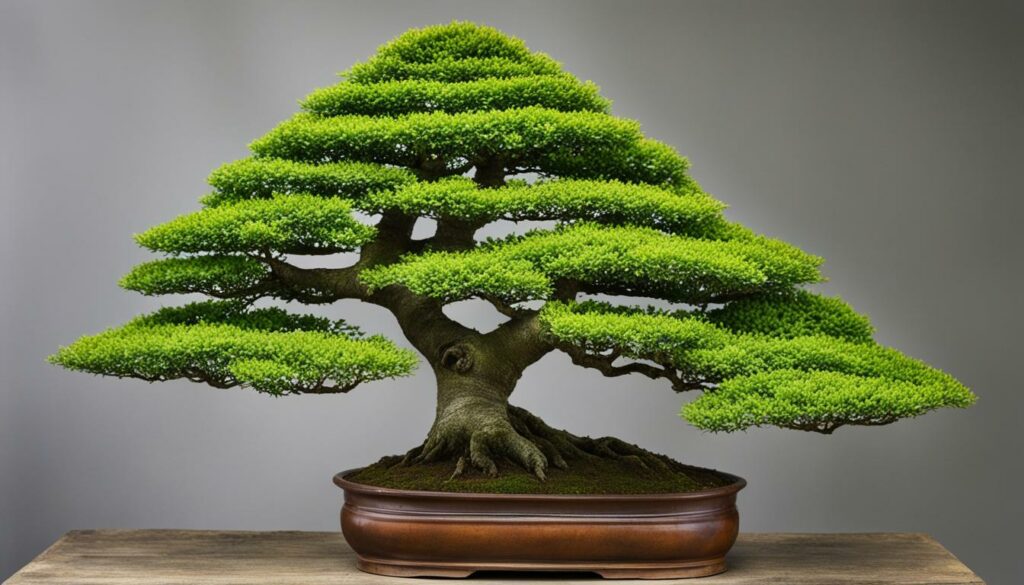
The Hornbeam Beech: A Sturdy Species
When it comes to bonsai trees, the Hornbeam Beech is a popular choice among bonsai enthusiasts. This deciduous tree species is known for its sturdy nature, making it an ideal choice for bonsai cultivation.
The Hornbeam Beech bonsai is an excellent option for beginners looking to dive into the world of bonsai, as it is relatively easy to care for and maintain.
One of the unique features of the Hornbeam Beech bonsai is its ability to withstand harsh weather conditions and temperatures, making it a hardy species suitable for outdoor display.
Another advantage of the Hornbeam Beech bonsai is its adaptability to a range of bonsai styles, including formal upright, informal upright, and slanting styles. With its fine-toothed leaves and beautiful smooth gray bark, the Hornbeam Beech bonsai can create a striking display in any bonsai collection.
“The Hornbeam Beech bonsai is an excellent option for beginners looking to dive into the world of bonsai, as it is relatively easy to care for and maintain.”
Selecting the Right Hornbeam Beech Bonsai
Choosing the perfect Hornbeam Beech bonsai requires careful consideration. Keep in mind that each specimen has its unique characteristics that determine its suitability for your collection.
Firstly, decide on the size and shape you desire. Hornbeam bonsai trees can be found in diverse shapes and sizes, from small shohin to large trees.
The next factor to consider is the age of the tree. Younger trees offer greater flexibility in shaping, whereas older trees have already begun to take shape, making them suitable for display.
Another essential factor is the health of the bonsai tree. Examine the foliage, stems, and roots to ensure that they are healthy and disease-free. A healthy tree will have shiny leaves, a sturdy trunk, and a well-developed root system.
Lastly, consider the soil and watering needs of the Hornbeam Beech bonsai to ensure it thrives in your care.
Hornbeam vs. Beech bonsai: What’s the difference?
The distinction between Hornbeam and Beech bonsai is subtle but crucial to understand when selecting a bonsai tree. Hornbeam bonsai trees have rough bark and pointed leaves that are slightly serrated. In contrast, Beech bonsai trees have smooth, gray bark and oval, serrated leaves. Keep these differences in mind when choosing your perfect bonsai tree.
Hornbeam Beech Bonsai Variations and Characteristics
| Variation | Characteristic |
|---|---|
| European Hornbeam (Carpinus betulus) | The preferred species for creating Hornbeam Beech bonsai with a desirable twisted trunk and gnarled bark. |
| American Hornbeam (Carpinus caroliniana) | A small, deciduous tree characterized by a smooth, blue-gray bark, making it an ideal species for shohin Hornbeam Beech bonsai. |
| Copper Beech (Fagus sylvatica) | A cultivar of Fagus sylvatica, the Copper Beech is characterized by its copper-purple leaves and smooth bark, making it a unique and attractive option for bonsai enthusiasts. |
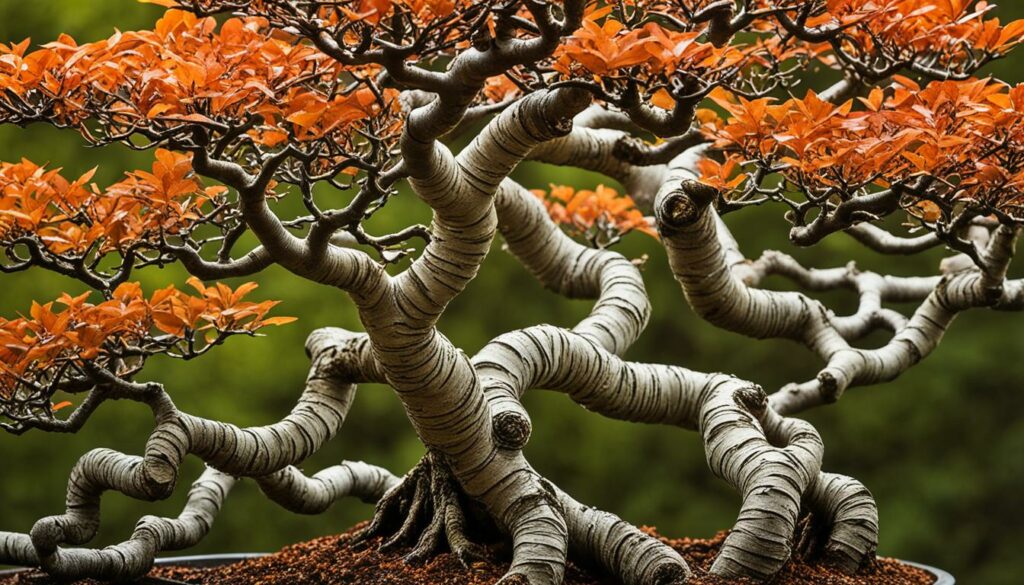
With these factors in mind, you’ll be well on your way to selecting the perfect Hornbeam Beech bonsai to add to your collection. Remember to exercise patience and care as you begin your journey with this enduring and beautiful bonsai tree.
Care and Maintenance of Hornbeam Beech Bonsai
Keeping your Hornbeam Beech bonsai healthy and thriving requires a little extra care, but the results are worth it. Here are some essential guidelines for maintaining the beauty of your bonsai tree:
- Watering: Proper watering is crucial for the health of your Hornbeam Beech bonsai. Water your tree when the soil feels slightly dry to the touch, but avoid overwatering as it can lead to root rot. Use a gentle, fine mist spray nozzle or watering can to water the soil evenly, keeping the foliage dry.
- Pruning: Regular pruning helps keep your bonsai tree in shape and stimulate new growth. Use sharp, clean pruning shears to trim back overgrown branches and foliage. Avoid cutting away too much at once, and leave some leaves on each branch to encourage photosynthesis.
- Fertilizing: Feed your Hornbeam Beech bonsai with a balanced, slow-release fertilizer during its active growing season. This will supply essential nutrients to support healthy growth and development.
- Repotting: Repot your bonsai tree every 2-3 years to refresh the soil and promote healthy roots. Choose a well-draining soil mix that contains a combination of organic and inorganic materials.
- Protecting: During the winter months, protect your Hornbeam Beech bonsai from freezing temperatures by keeping it in a sheltered location, such as a greenhouse or indoors near a bright window.
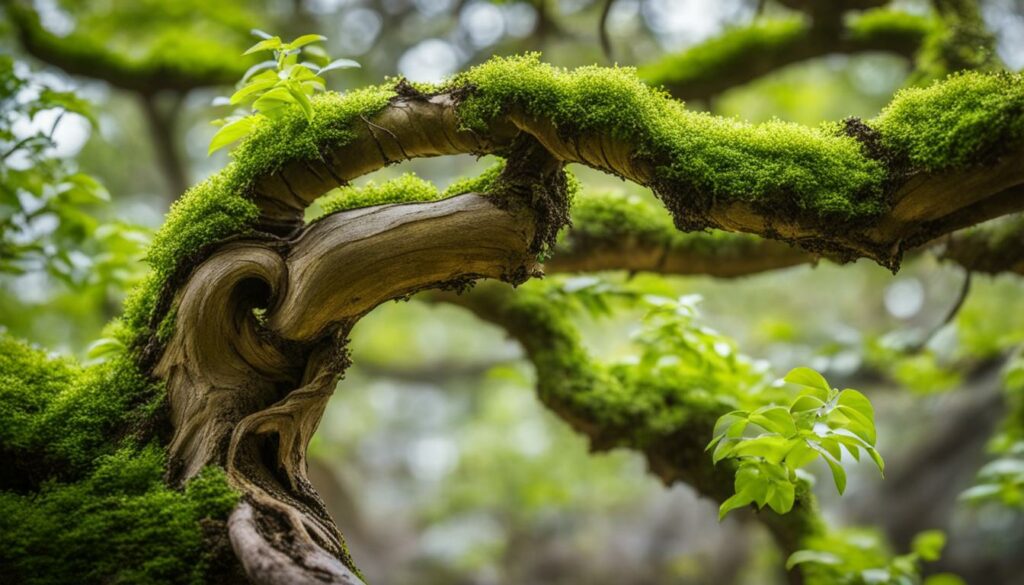
Following these care guidelines will help ensure the long-lasting beauty of your Hornbeam Beech bonsai. Remember to monitor its progress regularly and make adjustments as needed to maintain optimal health.
Styling Your Hornbeam Beech Bonsai
Now that you have selected your Hornbeam Beech bonsai, it’s time to explore different styling techniques to create an artistic and captivating display.
One option is to style your Hornbeam bonsai in the informal upright style, allowing the trunk to grow straight up, with boughs branching out in a more natural, asymmetrical form. You could also style it in the slanting style, where the trunk leans to one side, creating an elegant and dynamic appearance.
Another styling option is the windswept style, mimicking the appearance of a tree battered by strong winds. The branches all lean in one direction, with foliage only on the side where the wind is blowing. This style requires careful pruning to achieve a harmonious and balanced look.
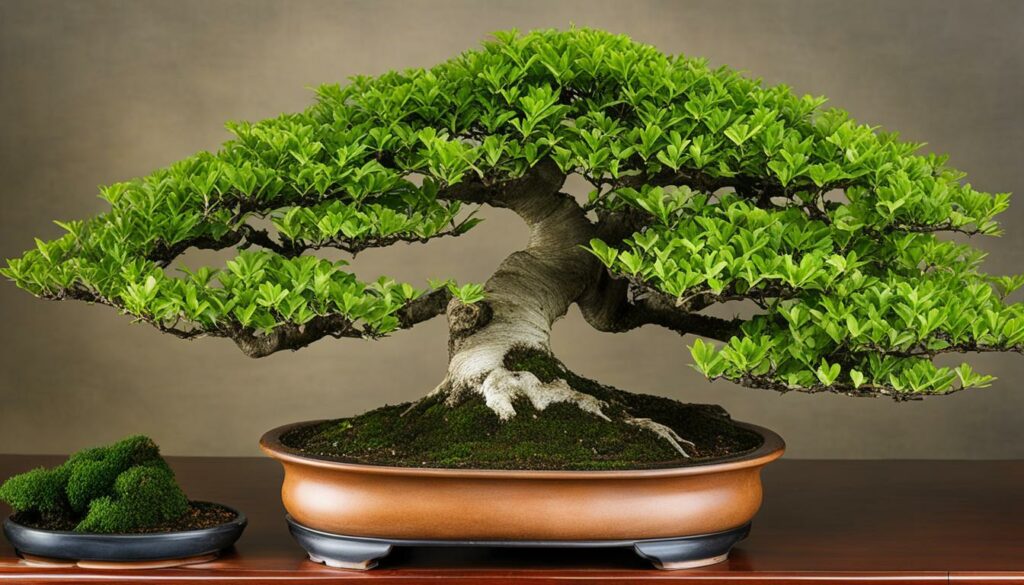
For a more contemplative display, consider the literati style, where the main trunk is thin and winds upwards, giving the impression of a tree isolated on a rocky cliff, battered by wind and standing in silhouette against the sky. This style demands patience and refined skills, and only experienced bonsai artists should attempt it.
There are many other styling options to choose from, each with its unique beauty and challenges. Whatever style you choose, ensure that your Hornbeam Beech bonsai remains healthy by providing it with the necessary care and maintenance.
Displaying Your Hornbeam Beech Bonsai
Now that you have selected and cared for your Hornbeam Beech bonsai, it’s time to showcase its beauty. A striking display can highlight the unique features of your bonsai and add elegance to your home.
The first step in displaying your Hornbeam Beech bonsai is choosing the right container. A shallow pot with a muted color can emphasize the natural beauty of the bonsai. You can also opt for a traditional Japanese ceramic pot with intricate designs for a classic look.
Positioning is crucial when displaying your Hornbeam Beech bonsai. Place it in a brightly lit spot to ensure it receives adequate sunlight for healthy growth. However, avoid direct sunlight, as it may damage the delicate leaves.
Consider adding mood lighting to enhance the ambiance of your display. Soft, warm lights can emphasize the natural beauty of your bonsai and create an inviting atmosphere in your home.
Remember to take into account the seasonal changes when displaying your Hornbeam Beech bonsai. In the winter, it is best to place it in a warm and dry area, while in the summer, it may benefit from being placed outdoors in a shaded area.
Your Hornbeam Beech bonsai is a true masterpiece, and displaying it in a thoughtful and elegant way can elevate the beauty of your home.
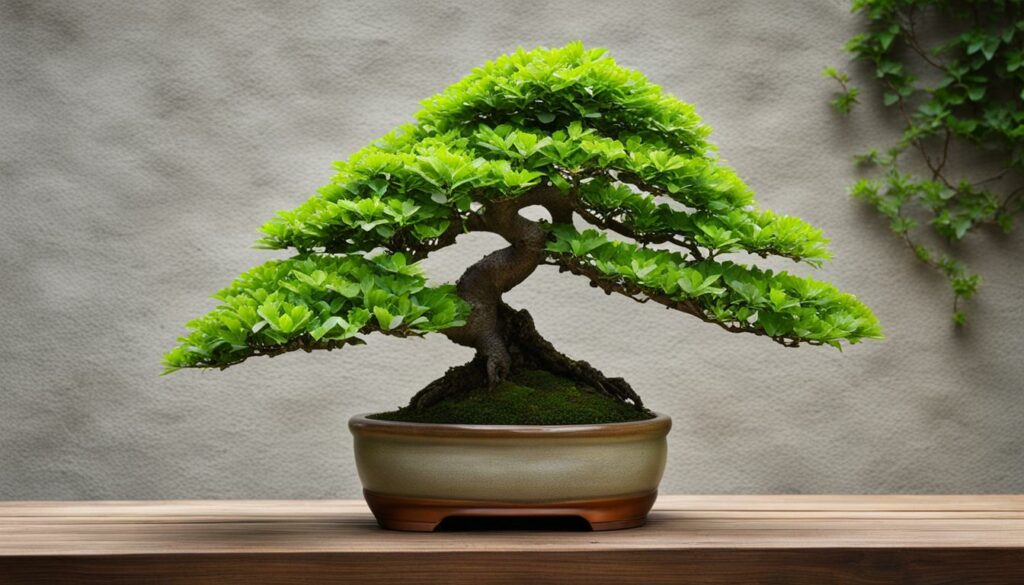
Hornbeam Bonsai: A True Work of Art
The Hornbeam Beech bonsai is not just a plant; it’s a living masterpiece. The art of shaping and refining the tree’s form takes years of patience and skill, resulting in a true work of art that brings beauty and serenity to your home.
The initial step of creating a stunning bonsai tree involves selecting the right young plant. The ideal specimen must be trained over time to create the desired structure. An experienced bonsai artist will consider various factors, including branch placement, trunk shape, and root development, to develop the tree’s overall form.
Once the initial form has been established the next step is to refine and shape the tree through regular pruning, wiring, and repotting. The tree’s shape must harmonize with nature while also providing an aesthetically pleasing display.
The final goal of Hornbeam Beech bonsai creation is to produce a tree that evokes a sense of natural beauty and peace that can be enjoyed for generations to come.
Bonsai Artistry Techniques
The art of Hornbeam Beech Bonsai is a skill that requires various techniques, including:
- Pruning – removing buds, shoots, branches, and foliage to shape the structure and promote growth
- Wiring – gently wrapping copper wire around branches to manipulate their position and shape
- Shaping – constructing and adjusting the tree’s shape by controlling growth and bending branches
- Repotting – refreshing the soil, root pruning, and potting the tree with suitable soil and nutrients for healthy growth
Hornbeam Bonsai Display
You can display your Hornbeam Beech bonsai in various settings and containers, including traditional Japanese style, or modern minimalism.
“A truly harmonized bonsai tree, in proportion and style, displayed in a suitable pot, will bring beauty, peace, and a sense of nature to any home.”
The art of Hornbeam Beech Bonsai is an enjoyable, fulfilling, and rewarding process that requires dedication and patience. By incorporating this masterpiece into your collection, you not only enhance your life but also increase your appreciation for nature’s true beauty.
Adding Beech Bonsai to Your Collection
Expand your bonsai collection with the beautiful Beech bonsai. Unlike the Hornbeam Beech, this deciduous bonsai has a smooth gray bark that sheds as the tree matures. Its leaves change color from green to gold in autumn, adding a vibrant touch to any collection.
Beech bonsai requires a bit more attention than Hornbeam, but the effort is worth it. The tree needs consistent moisture, but overwatering can cause root rot. The best way to combat this is to use a well-draining soil mix and avoid allowing it to sit in a wet saucer.
The Beech bonsai grows best in a container that is at least 10 inches deep, with a 2:1 soil to sand ratio. The optimal location is a bright spot, with filtered or direct sunlight of at least four hours a day.
Since Beech trees have a shallow root system, they require frequent fertilization. Use a balanced fertilizer with a high nitrogen content for vigorous growth and healthy leaves. Pruning should occur in spring, reducing the previous year’s growth to promote branching and new buds.
“The Beech bonsai has an elegance that makes it a popular choice among bonsai enthusiasts. Its smooth bark and vivid-colored autumn foliage make it a breathtaking addition to any bonsai collection.”
Exploring Deciduous Bonsai Trees
Now that you’re familiar with the Hornbeam Beech bonsai and its unique qualities, it’s time to broaden your horizons and explore other deciduous bonsai trees. Deciduous trees are known for their stunning displays of fall colors and diverse foliage.
One popular option is the Japanese Maple, which boasts delicate leaves that turn fiery shades of red and orange in the autumn months. Another option is the Bald Cypress, a coniferous tree with needle-like leaves that turn copper-colored in the fall.
If you’re looking for a more unique specimen, consider the Ginkgo biloba bonsai, which has distinct fan-shaped leaves and is one of the oldest tree species in the world.
Remember, when selecting a deciduous bonsai tree, pay attention to its specific requirements for light, water, and temperature. Keep in mind that these trees require more attention and care during the dormant period when they lose their foliage.
“The beauty of a deciduous bonsai is unmatched. Watching it change with the seasons is a true joy for any bonsai enthusiast.”
Conclusion: The Enduring Beauty of Hornbeam Beech Bonsai
Congratulations on making it to the end of the article! Now that you have explored the Hornbeam Beech bonsai, you can appreciate the enduring beauty of this species. This deciduous bonsai tree is sought after by enthusiasts due to its sturdy nature and unique characteristics.
Remember, when selecting your Hornbeam Beech bonsai, consider the specific features and variations that will suit your collection best. With proper care and maintenance, your bonsai tree will flourish and become a true work of art.
If you’re looking to expand your collection, consider the Beech bonsai and other popular deciduous bonsai species that can complement your Hornbeam Beech bonsai. These miniature masterpieces offer both a beautiful display and a fulfilling hobby.
Thank you for taking the time to learn about the Hornbeam Beech bonsai species. We hope this article has been informative and helpful in your bonsai journey. Stay tuned for more species profiles and bonsai tips!
FAQ
What is a Hornbeam Beech bonsai?
A Hornbeam Beech bonsai is a miniature version of the Hornbeam Beech tree, cultivated using bonsai techniques. It is known for its sturdy nature and striking appearance.
How big does a Hornbeam Beech bonsai grow?
The size of a Hornbeam Beech bonsai varies depending on the age and styling of the tree. Typically, it can range from 6 to 18 inches in height.
How often should I water my Hornbeam Beech bonsai?
The watering frequency for a Hornbeam Beech bonsai depends on various factors, such as the climate and the size of the tree. As a general guideline, it is recommended to water the bonsai when the topsoil feels slightly dry.
Can I keep a Hornbeam Beech bonsai indoors?
While it is possible to keep a Hornbeam Beech bonsai indoors, it is important to provide it with adequate light and air circulation. Ideally, it should be placed near a window or under grow lights to ensure its health and growth.
How do I prune my Hornbeam Beech bonsai?
Pruning is an essential part of bonsai care, helping to maintain the tree’s form and promote growth. To prune a Hornbeam Beech bonsai, use sharp bonsai shears to trim back new growth, remove unwanted branches, and maintain the desired shape.
Can I wire my Hornbeam Beech bonsai?
Yes, wiring is commonly used in bonsai cultivation to shape and style the tree. However, as Hornbeam Beech bonsai has relatively brittle branches, caution must be exercised while wiring to prevent damage.
Can I fertilize my Hornbeam Beech bonsai?
Fertilizing your Hornbeam Beech bonsai is important to provide it with essential nutrients. Use a balanced bonsai fertilizer during the growing season, following the manufacturer’s instructions for application.
How do I prevent pests and diseases in my Hornbeam Beech bonsai?
Regular inspections and proper care can help prevent pests and diseases in your Hornbeam Beech bonsai. Ensure good airflow, avoid overwatering, and address any issues promptly. If pest infestation or disease is detected, appropriate treatments should be applied.
Can I repot my Hornbeam Beech bonsai?
Repotting is an important part of bonsai maintenance, allowing for root health and proper growth. Hornbeam Beech bonsai should be repotted every 2-3 years during the spring, using a well-draining bonsai soil mix.
How long does it take for a Hornbeam Beech bonsai to mature?
The time it takes for a Hornbeam Beech bonsai to mature depends on various factors, such as the age of the tree when it was initially styled and the care it receives. On average, it can take several years to develop a mature and well-styled bonsai.
